The Magical Appearance of Magicicada
For immediate release ‐ May 05, 2021
Contact: Jon Pishney, 919.707.8083. Images available upon request
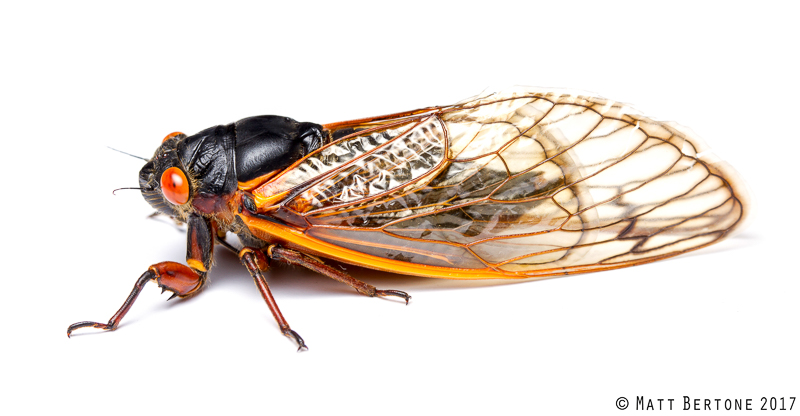 Brood VI Magicicada septendecim. Photo: Matt Bertone.
Brood VI Magicicada septendecim. Photo: Matt Bertone.
By Colin Brammer, PhD, Coordinator of the Natural World Investigate Lab
In the coming weeks, parts of the eastern United States are going to experience a rare and special treat: the mass emergence of millions of Magicicada periodical cicadas. Why a treat, you ask? It is one of nature’s mysteries and absolute wonders. Like seeing the Grand Canyon or a Giant Sequoia, the mass emergence of these creatures renders one awestruck at the magnificence of such a unique event.
Annual cicadas, also known as dog-day cicadas, spend about two years eating underground, and adults emerge every year for mating. But periodical cicadas eat and grow underground for either 13 or 17 years before emerging, depending on the species. This makes them the longest-lived insect species. No one truly understands why these cicadas take 13 or 17 years to develop, or how they evolved the ability to live so long as nymphs.
Adult Magicicada are black-bodied with translucent orange wings and bright red eyes. They are smaller than the green and black dog-day cicada, so there is no mistaking their identity if you have periodical cicadas emerging in your area.
Both annual and periodical cicadas are in the Order Hemiptera, which makes them “true bugs,” along with leafhoppers and planthoppers.
Cicada Lifecycle
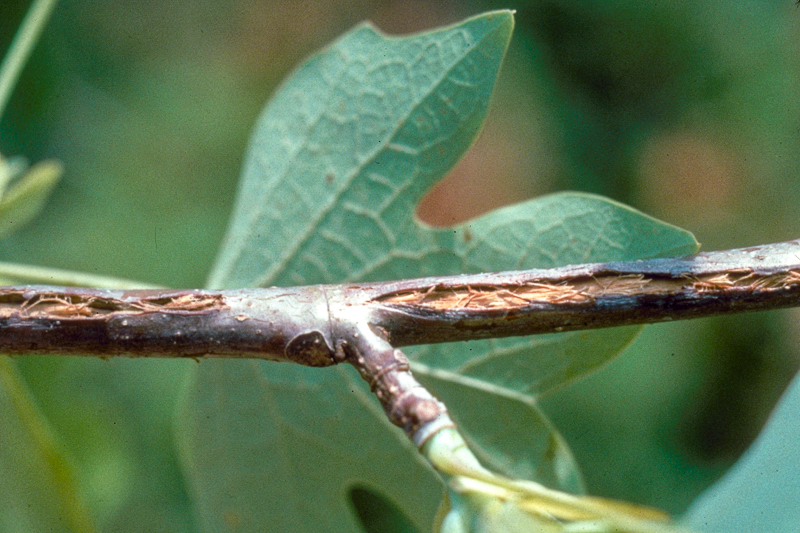 Magicicada egg-laying damage. Photo: Tim Tigner, Virginia Department of Forestry, Bugwood.org.
Magicicada egg-laying damage. Photo: Tim Tigner, Virginia Department of Forestry, Bugwood.org.
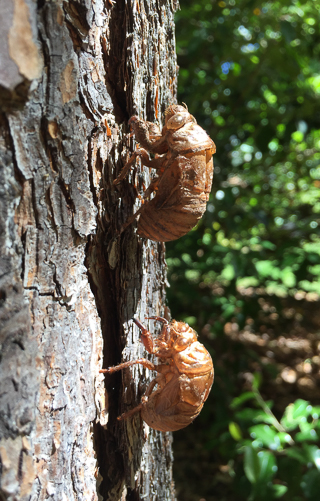
Cicada exuviae on tree trunk. Photo: Colin Brammer/NCMNS.
Female cicadas use their ovipositor (the egg-laying device on the end of their abdomen) to place an egg within the branch of a tree. Interestingly, the egg is not placed where the nymph, or immature cicada, will feed and grow. The nymph will emerge from the egg, feed for a short time, and then drop to the ground, where it will burrow and start to feed on tree and plant roots until it is its time to emerge.
As the nymph feeds and grows, it must molt – shed its exoskeleton – to grow. It will molt five times – each in-between stage is called an instar. When the conditions are correct, the final nymphal instar will crawl out of the ground, climb up a vertical surface and “hatch” or emerge from the last nymphal exoskeleton (the exuviae) into the imago, or adult stage. These exuviae are what one finds on the trunks of trees and wooden fence posts after the adult has emerged.
Safety in Numbers
The mass emergence of periodical cicadas is a “safety in numbers” survival strategy because many creatures enjoy snacking on them, like birds, snakes and lizards, insectivorous moles, plus skunks, rodents, opossums and even humans. Historically, American Indians used to gather the soft, just-emerging pre-adults and roast them as a tasty protein-packed snack! This is not an uncommon idea. To this day, there are many people who still practice entomophagy (eating insects), and it is the perfect opportunity to add a little variety to your diet.
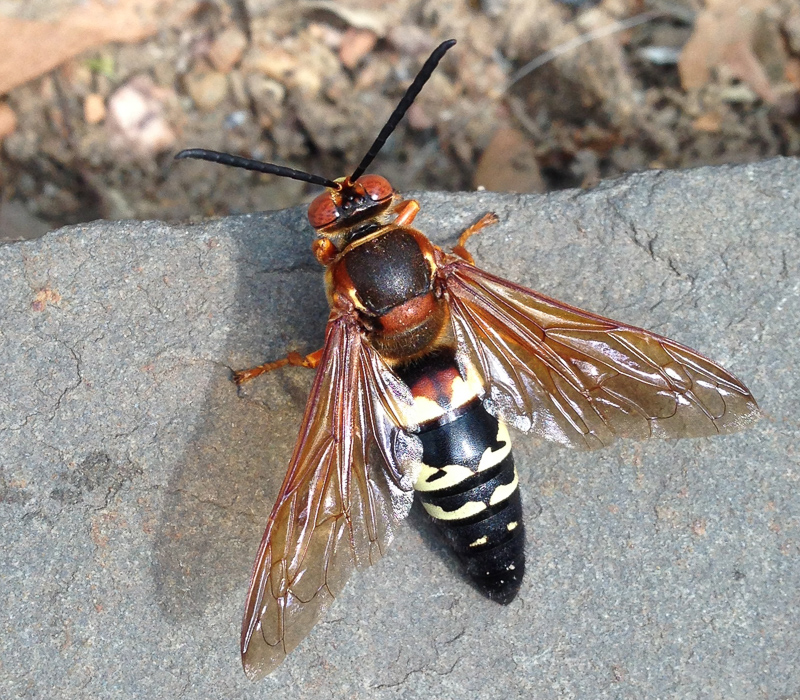 Cicada killer wasp. Photo: CC by Matthew Wills, Backyard and Beyond: As Big as a Lear Jet.
Cicada killer wasp. Photo: CC by Matthew Wills, Backyard and Beyond: As Big as a Lear Jet.
And then there are the infamous eastern cicada killers (Sphecius speciosus), one of five species of large solitary wasps of the Family Crabronidae found in the New World that specialize in preying on, you guessed it, cicadas. Late in the summer you may see these sleek black and yellow creatures hovering over a patch of earth and possibly burrowing into it.
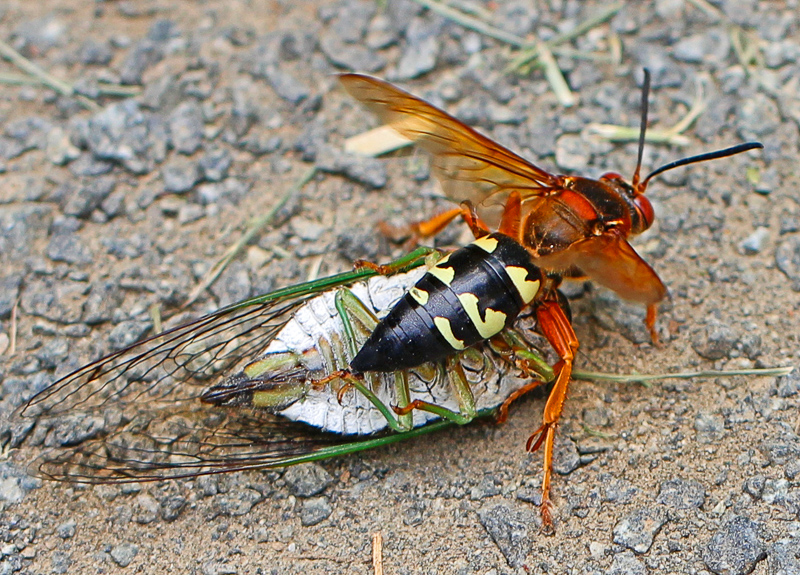 Eastern cicada killer wasp with cicada prey. Photo: CC by Judy Gallagher on Flickr.
Eastern cicada killer wasp with cicada prey. Photo: CC by Judy Gallagher on Flickr.
The female cicada killer will locate a cicada, sting it to paralyze it, then drag it back to the burrow to become food for their grub-like larvae. Although the female eastern cicada killer is quite large, some of the cicada prey are heavier than she is, so she tends to climb up surfaces like trees or fences, and then glide to the ground repeatedly until she reaches her burrow.
What’s That Buzzing?
Ahh, the romance … The loud, persistent, “Johnny Ramone guitar-buzz saw” sound you hear from these creatures is the male’s special love song to find his one-and-only. Males vibrate drum-like organs on the underside of their abdomens, known as tymbals, hundreds of times per second to create the buzzing cacophony. The females are attracted to the call and the male meets with her approval, they will mate to start the next generation. The reason it gets so loud is the sheer number of males, all singing at the same time.
There are 15 different groups of periodical cicadas, each given a different Roman numeral designation. In 2021, Brood X (Roman numeral 10) will emerge across the Mid-East and eastern United States. Although not the largest of broods, Brood X is the most widely distributed geographically. There are three species of Magicicada that emerge as Brood X; Magicicada septendecim, M. cassinii and M. septendecula.
Although it would be fantastic to have them emerge all over North Carolina, Brood X have only been known to emerge in Cherokee, Surry and Wilkes Counties. But if you live in other areas of the Southeast, such as Georgia, Kentucky, Tennessee, West Virginia or Virginia, they will be emerging as well.
So, whether you are anticipating the arrival of a potentially once-in-a-lifetime event, travelling to see it, or wanting to get away from it, Magicicadas by the millions will be upon us soon. Enjoy!
Calling song of a single Magicicada septendecim:
Fontaine, K. M., Cooley, J. R., & Simon, C. (2007). “Evidence for Paternal Leakage in Hybrid Periodical Cicadas (Hemiptera: Magicicada spp.),” PloS one, 2(9), e892.. doi: 10.1371/journal.pone.0000892
A Magicicada chorus containing M. septendecim, M. cassini, and M. septendecula:
Fontaine, K. M., Cooley, J. R., & Simon, C. (2007). “Evidence for Paternal Leakage in Hybrid Periodical Cicadas (Hemiptera: Magicicada spp.),” PloS one, 2(9), e892.. doi: 10.1371/journal.pone.0000892
For more information about our upcoming activities, seasonal news and ground-breaking research, follow @NaturalSciences on Instagram, Twitter and Facebook. Join the conversation with #visitNCMNS.

